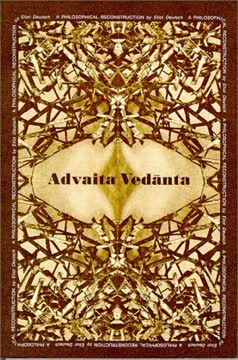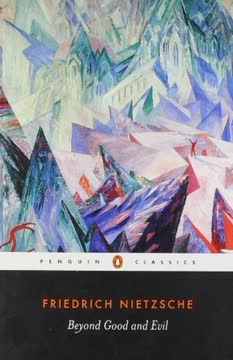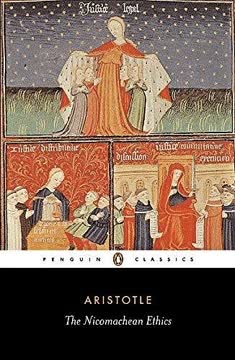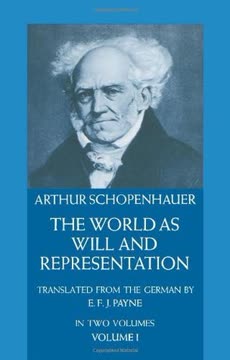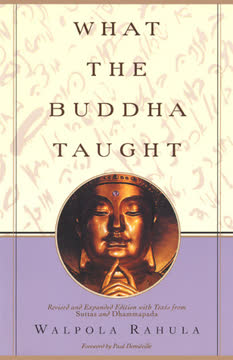Key Takeaways
1. Brahman: The Experience of Timeless Plenitude
Brahman is ultimately a name for the experience of the timeless plenitude of being.
Beyond Definition. Brahman is not a personal being or an impersonal concept, but a state of being experienced when subject/object distinctions vanish. It's designated as saccidananda: being (sat), consciousness (cit), and bliss (ananda), which are not attributes but terms expressing the apprehension of Brahman.
Phenomenological Basis. Brahman is experienced as pure, unqualified being, the ontological principle of unity. Consciousness (cit) points to the principle of awareness, an unchanging witness. Bliss (ananda) signifies the principle of value, an ecstatic state annulling all partial values.
Via Negativa. Brahman defies description, characterized by "neti neti" (not this, not this). Language, rooted in phenomenal experience, is limited in expressing states beyond that experience. Logic, grounded in the mind's relation to the phenomenal order, cannot affirm what extends beyond it.
2. Subration: Disvaluing Experience Through Contradiction
Subration is the mental process whereby one disvalues some previously appraised object or content of consciousness because of its being contradicted by a new experience.
Rectifying Errors. Subration is the mental process of rectifying errors by disvaluing a previously appraised object or content of consciousness due to contradiction by a new experience. It involves rejecting an initial judgment and replacing it with a new one believed to conform with reality.
Axiological and Noetic Dimensions. Subration involves a judgment, recognition of its faultiness, and acceptance of a new judgment. It's an axio-noetic process, revising judgment so that the former is radically denied by a new one based on fresh insight or experience.
Ontological Distinctions. Subration serves as a criterion for making ontological distinctions. When something is subrated, it's believed to have a lesser degree or kind of "reality" than what takes its place. The more something can be subrated, the less reality it has.
3. Reality, Appearance, and Unreality: A Hierarchy of Being
Reality is that which cannot be subrated by any other experience.
Non-Subratable Content. Reality is that which cannot be disvaluated, denied, or contradicted by anything else. It's the "content" disclosed in the highest form of human experience, transcending the "human" in any narrow sense.
Spiritual Identity. The only experience whose content cannot be subrated is pure spiritual identity, where the separation of self and non-self is transcended. This experience is celebrated as one of perfect insight, bliss, and power.
Appearance and Unreality. Appearance comprises experiences that can be subrated, while unreality is that which neither can nor cannot be subrated. This creates a hierarchy where Reality is incommensurable with Appearance and Unreality, valid only from the standpoint of rational-sense consciousness.
4. Maya: The World as a Pervasive Error
Whenever the "I," "me," or "mine" is present, according to Advaita, there also is maya.
Grounding in Error. The existence of an independent, substantial world of real objects, persons, and processes must be grounded in some pervasive error. We take the unreal for the real and the real for the unreal, which is maya.
Subject/Object Distinction. Maya is all experience constituted by and following from the distinction between subject and object, self and non-self. It's the ontic-noetic state where limitations are imposed upon Reality.
Beginningless and Indescribable. Maya is beginningless, unthinkable, and indescribable. It has the power of concealing reality and also of misrepresenting or distorting reality. The phenomenal world is maya, produced by maya, but not merely a figment of imagination.
5. Satkaryavada and Vivartavada: Cause and Manifestation
Those who think about creation . . . think that creation is the expansion of Isvara.
Effect in Cause. Advaita explains the relation between Brahman and the world in terms of satkaryavada, the theory that the effect pre-exists in its cause, with Brahman as the material and efficient cause. It also uses vivartavada, the theory that the effect is only an apparent manifestation of its cause.
Isvara's Sportive Activity. Isvara creates, sustains, and destroys worlds out of the sheer joy of doing so, a concept known as lila. This creative act is spontaneous, without any purpose, and removes all motive, purpose, and responsibility from Isvara.
Apparent Change. Creation is only apparent change, not a modification of Brahman in reality, hence vivartavada. From the standpoint of Brahman-experience, there is no creation; Reality is non-dual. The whole import of vivartavada is to bring the mind away from its involvement in maya.
6. Atman: The Pure, Undifferentiated Self
Silence is the Atman.
Beyond Labels. Atman is that pure, undifferentiated self-shining consciousness, timeless, spaceless, and unthinkable, that is not-different from Brahman and that underlies and supports the individual human person. It is a supreme power of awareness, transcendent to ordinary sense-mental consciousness, aware only of the Oneness of being.
Timeless and Spaceless. Atman is timeless, not subject to a "present" or an end in time. It is spaceless, as spatial relations hold only between objects of the empirical order. It is unthinkable, as thought functions only with forms, in multiplicity.
Not-Different from Brahman. Identity judgments such as "thou art that" (tat tvam asi) are not mere tautologies but concrete representations of a movement of thought from particularity to universality to unity. In the depth of my being, I am not-different from Reality.
7. Jiva: The Individual as a Combination of Reality and Appearance
We may call the jiva as a mere reflection of the Atman.
Reflection or Limitation. The individual human person, the jiva, is a combination of reality and appearance. It is "reality" so far as Atman is its ground; it is "appearance" so far as it is identified as finite, conditioned, relative.
Theories of Appearance. Two theories explain the status of the jiva: pratibimba-vada, the theory of reflection, where the jiva is a reflection of Atman on the mirror of avidya; and avaccheda-vada, the theory of limitation, where the jiva is a limitation of consciousness constituted by the upadhi of ignorance.
Phenomenology of Consciousness. The Advaitic analysis of the empirical self is primarily a "phenomenology" of consciousness, describing how we come to believe in the reality of an illusory appearance. It identifies states of consciousness from waking to deep sleep, each with its corresponding mis-identifications.
8. Karma: A Convenient Fiction for Moral Understanding
According as one acts, according as one conducts himself, so does he become.
Action and Consequence. According to the doctrine of karma, everyone is conditioned by their conduct over innumerable births, deaths, and rebirths. Every deed has its effect and forms a tendency that becomes the basis for future deeds.
Undemonstrable Law. For Advaita Vedanta, karma is a "convenient fiction," a theory that is undemonstrable but useful in interpreting experience. It cannot be secured by any of the pramanas or "means of valid knowledge."
Moral Preparation. Karma provides a ready means for instilling an awareness of being in bondage, which is necessary to inspire the quest for freedom. It persuades men to live a moral life by attaching tremendous importance to every moral act and decision.
9. Vidya and Avidya: The Higher and Lower Knowledge
There are two kinds of knowledge . . . the higher and the lower.
Incommensurable Knowledge. There are two kinds of knowledge: para vidya, the higher knowledge of the Absolute, and apara vidya, the lower knowledge of the world. These are incommensurable, as the higher knowledge is sui generis, reached intuitively and immediately.
Self-Certifying Insight. Para vidya possesses a unique quality of ultimacy that annuls any supposed ultimacy attached to other forms of knowledge. It is self-certifying, with no other form of lower knowledge capable of demonstrating or refuting it.
Justified Means. Until spiritual wisdom is attained, the lower hierarchy of knowledge holds good. The pramanas are justified as valid means of knowledge as long as they do not claim ultimacy for themselves.
10. Jnana-Yoga: The Path to Freedom Through Self-Knowledge
I teach you, but you understand not: silence is the Atman.
Positive Goal. Moksa, or freedom, is attained through the mental-spiritual discipline of jñana-yoga. It means attaining a state of "at-onement" with Reality and realizing the potentialities of man as a spiritual being.
Four Qualifications. The aspirant must possess the ability to discriminate, disregard sensuous pleasures, acquire mental tranquility, and have a positive longing for freedom and wisdom. These qualifications require a radical change in the natural direction of consciousness.
Three Stages. The three stages of jñana-yoga are "hearing," which involves acquaintance with the teachings of Advaita; "reflection," which involves rational reflection on these teachings; and "meditation," which involves the attainment of direct, intuitive insight into the nature of Reality.
Last updated:
FAQ
1. What is "Advaita Vedanta: A Philosophical Reconstruction" by Eliot Deutsch about?
- Philosophical Reconstruction: The book offers a systematic, philosophical reconstruction of Advaita Vedanta, focusing on its core doctrines and their relevance to universal philosophical questions.
- Bridging East and West: Deutsch aims to present Advaita Vedanta not just as an exotic or historical curiosity, but as a living philosophy with intrinsic value for both Eastern and Western thinkers.
- Emphasis on Experience: The work highlights Advaita Vedanta as both a rigorous philosophical system and a practical guide to spiritual realization, emphasizing the unity of thought and experience.
- Accessible Analysis: Rather than focusing on scriptural exegesis, Deutsch distills the tradition’s philosophical content in terms accessible to students of philosophy worldwide.
2. Why should I read "Advaita Vedanta: A Philosophical Reconstruction" by Eliot Deutsch?
- Universal Relevance: The book demonstrates how Advaita Vedanta addresses universal philosophical problems, making it relevant for anyone interested in metaphysics, epistemology, or spirituality.
- Clarity and Depth: Deutsch provides clear explanations of complex concepts, making the tradition approachable without oversimplifying its depth.
- Comparative Philosophy: Readers gain insight into how Eastern and Western philosophies can inform and enrich each other.
- Practical Application: The text connects philosophical ideas to practical spiritual experience, offering guidance for personal growth and self-realization.
3. What are the key takeaways from "Advaita Vedanta: A Philosophical Reconstruction"?
- Non-Dual Reality: Advaita Vedanta posits that ultimate reality (Brahman) is non-dual, transcending all distinctions between subject and object.
- Levels of Being: The tradition distinguishes between Reality, Appearance, and Unreality, using the concept of subration to analyze the hierarchy of existence.
- Self and Liberation: The true Self (Atman) is identical with Brahman, and realizing this identity leads to liberation (moksha).
- Epistemological Hierarchy: Knowledge is divided into higher (para vidya) and lower (apara vidya), with spiritual knowledge being self-certifying and ultimate.
- Ethics and Practice: While transcending conventional morality, Advaita Vedanta prescribes ethical preparation and mental discipline as prerequisites for self-realization.
4. How does Eliot Deutsch define and explain Brahman in "Advaita Vedanta: A Philosophical Reconstruction"?
- Beyond Attributes: Brahman is described as saccidananda—being (sat), consciousness (cit), and bliss (ananda)—but these are not attributes, rather expressions of the experience of Brahman.
- Via Negativa: Brahman is ultimately beyond all description; it is best approached through negation (neti neti—not this, not this), as all positive characterizations are limiting.
- Two Modes: Advaita distinguishes between nirguna Brahman (without qualities) and saguna Brahman (with qualities), the latter being Brahman as conceived by the mind.
- Experiential Reality: Brahman is the fullness of being experienced in non-dual spiritual realization, where all distinctions are transcended.
5. What are the "levels of being" in Advaita Vedanta according to Eliot Deutsch?
- Three Levels: Deutsch reconstructs Advaita’s ontology into Reality (non-subratable, ultimate), Appearance (subratable, phenomenal), and Unreality (self-contradictory, impossible).
- Subration as Criterion: The process of subration (bādha) is used to distinguish these levels—what can be subrated is less real than what cannot.
- Hierarchy of Experience: Reality is the content of non-dual experience; Appearance includes empirical and illusory existents; Unreality refers to logical impossibilities.
- Philosophical Implications: These distinctions are valid from the standpoint of reason and experience but are themselves transcended in the realization of Reality.
6. How does "Advaita Vedanta: A Philosophical Reconstruction" address the relationship between Brahman and the world?
- Maya and Avidya: The world is seen as an appearance (maya), produced by ignorance (avidya) and superimposition (adhyasa) upon Brahman.
- Satkaryavada and Vivartavada: Advaita adopts satkaryavada (effect pre-exists in cause) and vivartavada (the world is an apparent manifestation, not a transformation, of Brahman).
- No Ultimate Causality: From the highest standpoint, no real causal relation exists between Brahman and the world; causality is a provisional, empirical concept.
- Practical Function: Theories of creation and causation serve to guide the aspirant from empirical reality toward the realization of non-duality.
7. What is the nature of the Self (Atman) in "Advaita Vedanta: A Philosophical Reconstruction"?
- Identity with Brahman: The Self (Atman) is pure, undifferentiated consciousness, timeless, spaceless, and ultimately identical with Brahman.
- Phenomenology of Consciousness: Deutsch analyzes four states—waking, dreaming, deep sleep, and transcendental consciousness (turiya)—to show the progression toward self-realization.
- Metaphors for the Individual: The jiva (individual self) is explained through the metaphors of reflection (pratibimba-vada) and limitation (avaccheda-vada), both illustrating the illusory nature of individuality.
- Liberation through Knowledge: Realizing the non-difference between Atman and Brahman is the key to overcoming ignorance and attaining freedom.
8. How does Eliot Deutsch explain the doctrine of karma in Advaita Vedanta?
- Karma as Convenient Fiction: Within Advaita’s metaphysical and epistemological framework, karma is undemonstrable by any valid means of knowledge (pramana) and is thus a "convenient fiction."
- Practical Utility: The doctrine of karma is retained for its practical value in moral preparation, motivation for spiritual practice, and explanation of human inequality.
- Transcendence in Realization: Upon realization of Brahman, karma and its effects are transcended; they apply only to the empirical self, not the true Self.
- Not Empirically Verifiable: Deutsch argues that karma cannot be established through perception, inference, or scriptural testimony as ultimate truth.
9. What are the main aspects of Advaitic epistemology as reconstructed by Eliot Deutsch?
- Hierarchy of Knowledge: Knowledge is divided into higher (para vidya—knowledge of Brahman) and lower (apara vidya—empirical knowledge), with the former being self-certifying and ultimate.
- Means of Knowledge (Pramanas): Advaita recognizes six pramanas—perception, inference, comparison, non-cognition, postulation, and testimony—but only as valid within the empirical realm.
- Self-Validity of Cognition: All knowledge is considered valid until contradicted by a higher experience; ultimate validity belongs only to the knowledge of Brahman.
- Realistic Epistemology: In the empirical world, Advaita maintains a "soft realism," affirming the distinction between subject and object while recognizing its provisional nature.
10. How does "Advaita Vedanta: A Philosophical Reconstruction" approach ethics and moral values?
- Transcendence of Morality: For the realized person, Brahman is beyond good and evil; conventional morality is transcended in non-dual realization.
- Instrumental Ethics: Ethical conduct and virtues are valued as preparatory disciplines (sadhana) for self-realization, not as ends in themselves.
- Criterion of Goodness: Actions are judged good if they lead toward self-realization and bad if they reinforce egoism and bondage.
- Practical Morality: For those not yet realized, adherence to traditional moral codes and cultivation of virtues like self-control, compassion, and truthfulness are recommended.
11. What is the method of liberation (moksha) and the role of jnana-yoga in "Advaita Vedanta: A Philosophical Reconstruction"?
- Jñana-Yoga Path: Liberation is attained through the discipline of knowledge (jñana-yoga), involving discrimination, renunciation, self-control, and longing for freedom.
- Three Stages: The process includes hearing (sravana), reflection (manana), and constant meditation (nididhyasana) on the teachings of Advaita.
- Experiential Realization: The culmination is direct, intuitive realization of the identity between Atman and Brahman, leading to freedom from bondage.
- Role of Tradition and Guru: Study of scriptures and guidance from a teacher are important, but personal insight and meditative experience are essential.
12. What are the best quotes from "Advaita Vedanta: A Philosophical Reconstruction" by Eliot Deutsch and what do they mean?
- "To know is to be": This encapsulates the Advaitic view that true knowledge is not merely intellectual but transformative, leading to direct realization of one’s identity with Reality.
- "There is no other or better description [of Brahman] than this; that it is not-this, not-this (neti neti).": This quote highlights the ineffability of Brahman and the necessity of approaching it through negation rather than positive attributes.
- "Reality is that which cannot be subrated by any other experience.": This defines the Advaitic criterion for ultimate reality, distinguishing it from all that is subject to change or contradiction.
- **"Brahman is real, the world is illusory, the self is not-different from Brahman.":
Review Summary
Advaita Vedanta by Eliot Deutsch is highly regarded as an excellent introduction to this Hindu philosophical system. Readers praise its lucid explanations of complex concepts like Brahman, Maya, and non-dualism. Many find it thought-provoking and a valuable resource for understanding Eastern mysticism. While some note its academic style can be challenging, most appreciate its clarity and depth. The book is seen as a concise yet comprehensive overview, inspiring further exploration of Advaita Vedanta. Several reviewers mention re-reading it to fully grasp its profound ideas.
Similar Books
Download PDF
Download EPUB
.epub digital book format is ideal for reading ebooks on phones, tablets, and e-readers.
